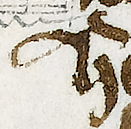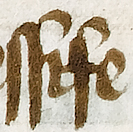|
| A |
 | Usage: Principally
double compartment 'a' is used throughout. |  | Usage: That
usually the two compartments appear to be the same size. |
 | Usage: fale
occasionally the upper compartment is bigger than the lower. |  | Usage: Alas
a distinctive upper case 'A' used throughout on the folios examined. It is the horizontal bar which crosses the graph at the top of the lobe which is different. |
|
| D |
 | Usage: desire
the scribe uses unlooped 'd' which varies little whether in initial, medial or final position. |  | Usage: stered |
 | Usage: dedis
the angle of the down-stroke is essentially the same in each example. |  | Usage: mandato
medial 'd' in the Latin gloss in the hand of the scribe. |
|
| G |
 | Usage: guerdon
all the scribe's graphs are controlled and evenly formed. Tailed 'g' is used throughout and again there is little variation in the graph. |  | Usage: kynge
there may be slight variation in the curve of the tail-stroke. The head of the graph is almost always the same with a thick descender sometimes slightly curved as in this example. |
 | Usage: regimine
'g' from Latin gloss in the hand of the scribe. |  | Usage: Gracious
upper case 'G'. |
|
| H |
 | Usage: honoure
lower case 'h' varies little and is always neatly executed. |  | Usage: Herkenith
in the combination 'th' in final position, 'h' is always crossed. |
 | Usage: Schall |  | Usage: Herkenith
distinctive looped side-stroke variant on the 'h' graph for the upper case rendition. The head-stroke is no longer a loop but a separate stroke curved at each end. |
|
| R |
 | Usage: roiall
modern 'r' is used in initial, medial and final positions. The formation does not vary. |  | Usage: dispreise
'z'-shaped 'r' used after 'o', 'p' and 'w'. |
 | Usage: hedir
'r' in final position. |  | Usage: Reioyse
upper case 'R' at the beginning of a line. |
|
| S |
 | Usage: schuldyn
long 's' is used in initial and medial positions. The head-stroke is separately scribed and curves down to form a ligature with the following 't'. |  | Usage: dedis
kidney 's' is used exclusively in final position. |
 | Usage: excessife |  | Usage: Schall
the curving top stroke of upper case 'S' ends with a final loop back to connect with the stroke. |
|
| W |
 | Usage: worthi
the scribe has two variant shapes for the 'w' graph which are used randomly. This variant has a third stroke at the right forming a single lobe. |  | Usage: woo
this variation of 'w' has a double, 'B'-shaped element on the right side. |
 | Usage: tweyne
't' connects with the left curved arm of the 'w' graph. |  | Usage: Whiche
upper case 'W' has a horizontal stroke across the top of the graph. |
|
| Y |
 | Usage: lyue
the scribe's formation of 'y' is extremely regular. |  | Usage: atteyne
the angle of turn on the tail of 'y' varies little. |
 | Usage: seyne
occasionally the tail of 'y' extends a little further than usual. |  | Usage: annuyte |
|
| Thorn and Yogh |
 | Usage: þinge
the stem of thorn is copied at an angle. Thorn is used only occasionally. |  | Usage: þt
abbreviation with superscript 't' neatly housed in the fork between the stem and lobe of thorn. |
 | Usage: ȝerely
yogh used initially as equivalent of 'y'. |  | Usage: myȝt
yogh is also used as equivalent of 'gh' in this combination. |
|
| Upper Case Letters |
 | Usage: That
the scribe has a number of distinctive forms for upper case letters. |  | Usage: But |
 | Usage: I |  | Usage: O |
|
| More Upper Case Letters |
 | Usage: Cursius |  | Usage: Pricipally |
 | Usage: No |  | Usage: Exemplu(m) |














































